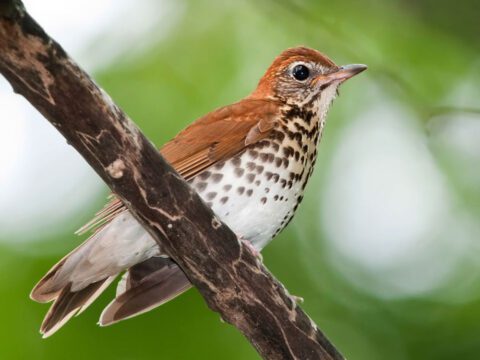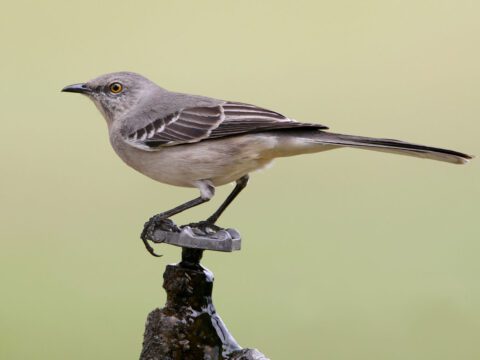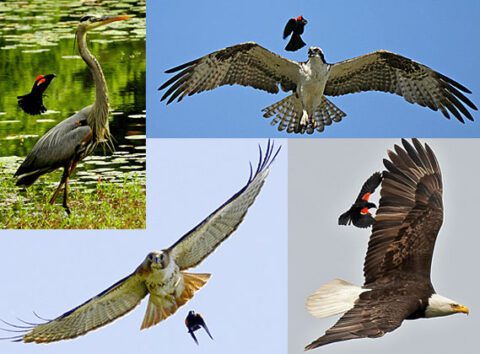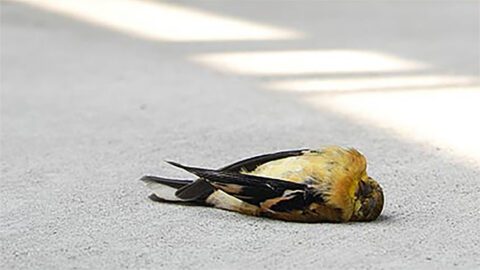Declining Numbers of Cerulean Warblers
By Sasha Paris and Laura Erickson
October 15, 2009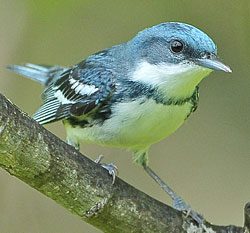
Partnerships working to reverse declines
The Cerulean Warbler is inextricably connected to American energy policies. Eighty percent breed in the Appalachian Mountains, where mining and land reclamation are important issues. And ceruleans winter on the eastern slopes of the Andes in northern South America, migrating through the Gulf Coast where wind farms are becoming an issue.
These beautiful birds, described as “sky blue, sky high” by Paul H Hamel, are canopy dwellers preferring large, dense forests with a structurally diverse canopy, especially stands with super-dominant canopy trees. They’re among the rarest of Neotropical migrant songbirds, listed on the Partners in Flight watch list and as a focal species by the U.S. Fish and Wildlife Service (USFWS). Breeding Bird Survey data indicate that their population declined at an average annual rate of 2.8 percent between 1966 and 2008, a 70 percent loss since 1966.
Ken Rosenberg, director of Conservation Science at the Cornell Lab of Ornithology, is working with a wide variety of partners to conserve this vulnerable bird. From 1995–2000, the Lab’s Cerulean Warbler Atlas Project used data from citizen scientists to map the current breeding range. On the breeding grounds, researchers have been striving for “no net loss,” identifying the most critical breeding sites and focusing on improving logging and mining practices, reclamation, and mitigation. Ken notes, “Forest managers in the Appalachians are the primary stewards of Cerulean Warbler breeding habitat.” Forestry practices that mimic natural disturbances and promote mature stands and large trees with spreading crowns can ensure ideal breeding habitat.
Researchers at the University of Tennessee estimated in 2006 that surface mining could displace 23 percent of the Cerulean Warblers in Tennessee’s Cumberland Mountains, one remaining stronghold. Mountaintop removal mining slices the tops from ridges, where the warblers prefer to nest, and dumps the rubble in nearby valleys. In September 2009, the Environmental Protection Agency withheld 79 mountaintop- mining permits for review, concluding that these projects would likely impact water quality, requiring review under the Clean Water Act. This action was not taken to help Cerulean Warblers, but will benefit them in the short run, and more acceptable practices for mining and reclamation will likely help the warblers in the long term as well. Reclamation practices and mitigation can also help us achieve “no net loss.”
Improving Cerulean Warbler survival rates during migration and on their wintering grounds may have a bigger effect on their population than focusing strictly on their breeding range, because core populations have a low annual survival rate and most mortality seems to occcur away from their breeding grounds. They migrate along the Gulf of Mexico, where wind farms may have a serious effect. (See An Answer Is Blowin’ in the Wind, in this issue.)
The Cerulean Warbler Conservation Initiative, “El Grupo Ceruleo,” brings together diverse partners including the Cornell Lab, USFWS, U.S. Forest Service, Pro Aves Colombia, American Bird Conservancy, and The Nature Conservancy, focused on research to better define the current range and identify important areas for wintering Cerulean Warblers. Already the American Bird Conservancy and ProAves have purchased 500 acres of rural land in the heart of the species’ wintering range. This Cerulean Warbler Reserve is the first protected area in Latin America to be designated specifically for a migrant bird, and is recognized by the Alliance for Zero Extinction because at least six very rare and critically threatened bird species are protected within it. Cerulean Warbler conservation has raised awareness of other conservation issues in Colombia as well, and the bird may serve as a “flagship species” promoting biodiversity in the Andes.
Ken Rosenberg says, “This 9-gram bird is helping to put an international spotlight on local conservation issues of global importance, from northern hardwood forests and the Appalachian Mountains through the Gulf of Mexico to the Andes.”
Originally published in the October 2009 issue of BirdScope.

All About Birds
is a free resource
Available for everyone,
funded by donors like you
American Kestrel by Blair Dudeck / Macaulay Library

